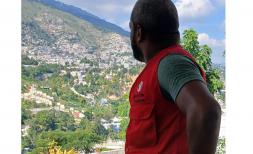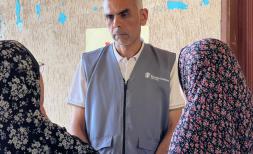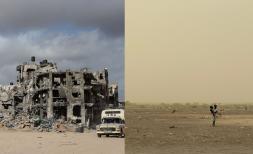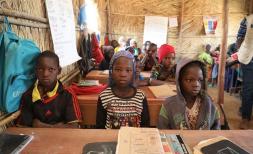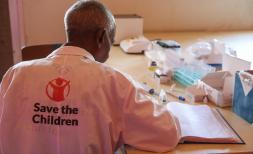Education is a Lifeline in Emergencies
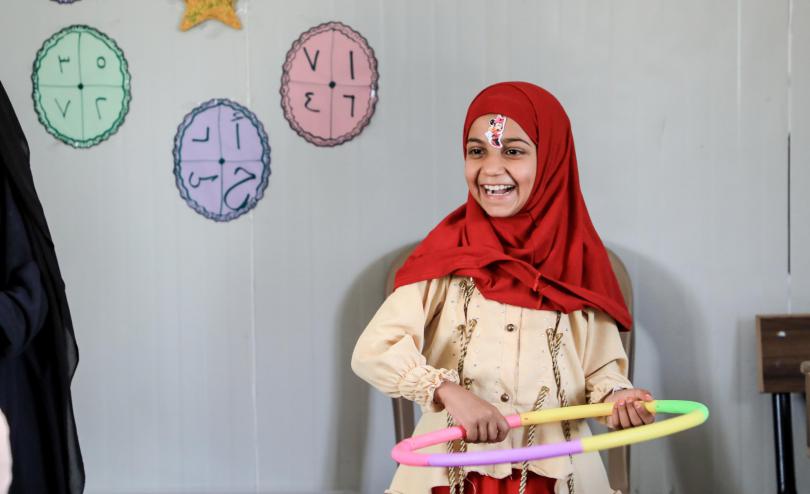
Sandi*, 9, during an activity at Save the Children's Temporary Learning Space in a displacement camp in Northeast Syria. Roni Ahmed / Save the Children
As many children across the world head back to school over the coming weeks, millions of children are being robbed of their education because they are caught up in conflict and emergencies. Nearly 15 million refugee children have had their learning interrupted after being forced to flee their homes.
In the first phase of an emergency, education can protect children and save lives. It can provide a sense of stability, and a chance to regain essential cognitive skills, as well as essential lifesaving learning like how to stay safe from unexploded bombs or how to prevent the spread of disease.
Our Safe Spaces provide vital psychosocial support to children who may be in extreme distress. Learning activities like expressive art, games to practice problem solving, and simple breathing techniques help children to recover emotionally. The simple routine of learning and playing with friends with support from safe adults is key to children’s wellbeing. We then gradually introduce more academic learning like reading and writing.
We also know that education is important to children from crises-affected countries, with going back to school ranked as their highest concern.
We have asked four humanitarians to share their experiences of how lifesaving learning can help children from across the world who are living through emergencies:
Soha Aburamadan, Save the Children Education in Emergencies Specialist, Gaza
During emergencies, education provides life-saving information that strengthens survival skills and coping mechanisms for children.
Our learning spaces in Gaza provide a crucial support system for children by helping them cope with the severe psychosocial impact of the violence. By establishing structure and routines, these spaces offer a sense of normalcy and stability. They focus on enhancing coping skills and self-care, encouraging children to build resilience and manage their emotional wellbeing in challenging environments.
Huda*, a six-year-old girl currently living in a shelter, witnessed the killing of her entire family and was left in severe psychosocial distress. She isolated herself and refused to interact with others. Initially, her aunt had to encourage her to attend psychosocial support (PSS) and learning activities. However, as she attended more sessions, Huda*’s attitude began to change. She started combing her hair, changing her clothes, and interacting positively with other children. Huda’s aunt said:
“She keeps asking to go daily to the activities. She wakes me up early to assist her in combing her hair and changing her clothes. I can feel that Huda* has come back to life."
A support facilitator at the al-Karama shelter, said:
“The start was very hard, as the children were so traumatized, suffering from many losses and lacking essential services. After several psychosocial sessions and returning to structured learning and regular attendance, they built a sense of safety and addressed grief and stress.”
Education saves lives. It can also provide a foundation for resilience, hope, and the rebuilding of communities who have lost everything.
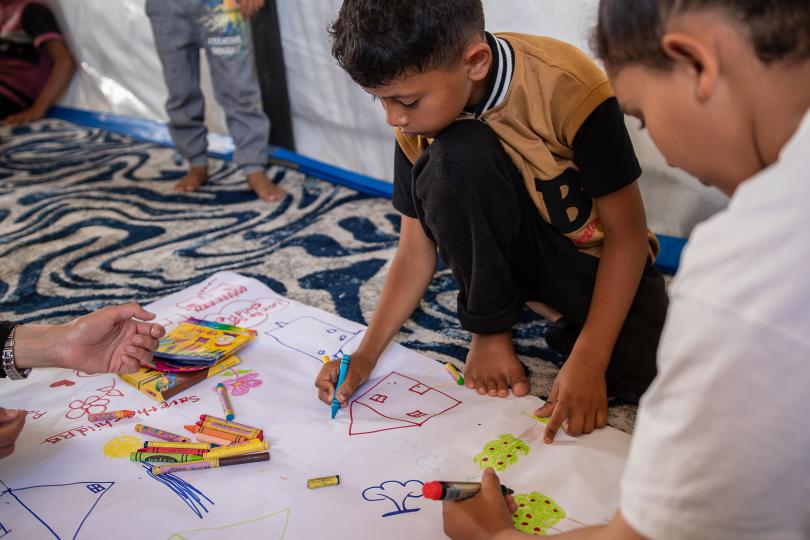
Shadi* (8) and his cousin Aya* (13) attend's Save the Children's learning space in Gaza. Sacha Myers / Save the Children
Gabriella Waaijman, Save the Children Chief Operating Officer and former Global Humanitarian Director
Back in early 2012, I was working for the UN Office for the Coordination of Humanitarian Affairs (OCHA) and I was asked to urgently go to South Sudan to lead their operation there. Newly independent, there was a significant outbreak of fighting in Pibor.
We had planned to focus the funding on four lifesaving areas - Health, Nutrition, Food Security and WASH. Education was not included, and the humanitarian leadership were convinced that it shouldn't be prioritised.
I chaired a meeting with the Humanitarian Country Team and the Cluster Coordinators in a small meeting room in the middle of a dusty compound. As we wrapped up the funding meeting and I stepped out into the blazing heat of Juba's dry season, I was cornered by Save the Children's Education Cluster Coordinator. She said:
"Education is lifesaving! It's been globally agreed, so why is this being disregarded? But also, let me give you the arguments."
And then she explained in words I will never forget, that children need a safe space, and that is what education in emergencies provides - children will be married off, put out to work, recruited, if they aren't safe. In education programmes, we add additional services, we can monitor children, and make referrals. Education is the first port of call, and it is where children can be together and protected.
Education in emergencies in the first phase of a response is lifesaving: it is safety, and it is an entry point for children to access other critical services.
Since then, I have been sold, and I have been an advocate for education in emergencies as a lifesaving sector. That Save the Children colleague opened my eyes to the way we were making decisions on behalf of children with an adult lens, without accountability to the people we were there to serve.
Unfortunately, over a decade later, decisions made by adults on behalf of children, continue to lack accountability and deprioritise education when it is needed most - in occupied Palestine territory, in Yemen, in Sudan – in all these places education saves lives, and we need to ensure more children get the chance to live and learn.
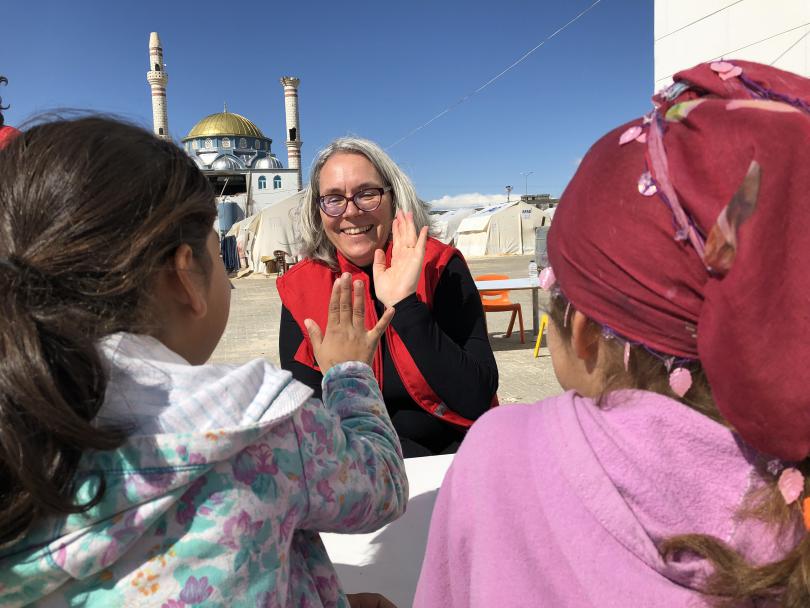
Gabriella Waaijman visits Child Friendly Sapce for children affected by earthquakes in Turkiye. Gudmund de Stordeur Baudinet/Save the Children
Janti Soeripto, President and Chief Executive Officer of Save the Children, United States
In many of the contexts in which we work, particularly in conflict zones, there are competing priorities – from healthcare to water, sanitation and hygiene to nutrition to education to shelter. Unfortunately, for some, it’s easy to overlook the importance of education or to dismiss it as a lesser priority, as ‘not lifesaving.’
But we disagree. Education in emergencies is lifesaving. Children tell us what they want most when in a crisis: ‘to go back to school’. Education – together with play – fuels curiosity, sparks creativity and helps their development. It helps them remain calm and retain a sense of normalcy in conflict or times of emotional unrest. Critically, being with their friends helps them, too. It’s a vital component of our mental health and psychosocial work.
After the 2023 earthquake in Türkiye, when children first came to our Safe Spaces, many didn’t talk - or laugh or play. But, after a few weeks, I saw a group of active, loud (!) and chatty 6–12-year-olds who had not only started to process extremely distressing events, but who were simply happy to be children again.
Also in 2023, I travelled to Ukraine, where we visited our digital learning centres, where children could safely access learning materials, interact with peers and receive mental health support. At that time, hundreds of thousands of children were out of school – we visited several schools destroyed by the fighting.
To see children learning and laughing was remarkable and heartwarming – but not surprising. I have seen it many times across the world, across different crises. Children are indeed resilient, but having access to spaces where they can simply be children makes that resilience much more likely to happen.
Children complete a listening test during classes at a subway school in Kharkiv, Ukraine. Anastasiia Zahoskina/Save the Children
Manuela Tiyu, South Sudan Education Cluster Co-Coordinator, Universal Network for Knowledge and Empowerment Agency (UNKEA), a Save the Children partner
Goi is a 12-year-old South Sudanese boy, who has been living in a transit centre in South Sudan for over two months.
Goi was originally displaced to Sudan before the conflict started. He then fled to South Sudan with his family when fighting erupted in Khartoum, the capital city of Sudan. Sadly, Goi’s parents were killed so he now lives with his aunt and sisters in the temporary shelter.
Along with other children in the centre, Goi is receiving vital learning support, including psychosocial activities to help him cope emotionally, as well as literacy and numeracy activities. But Goi wants to return to school. He misses the calm comfortable reading and learning environment of school.
Goi’s situation highlights the lack of educational resources for displaced children, emphasising the urgent need for prioritised educational support to secure their futures. Education must be prioritised.
---
We call on all governments, donors and organisation to recognise education in emergencies services as lifesaving and ensure its embedded within the first phases of every crisis response. Countless lives will be lost if it's not.
Earlier this year, Save the Children, with support from The Lego Foundation, launched its Education in Emergencies Rapid Response Fund, to support children affected by acute crises access lifesaving learning and wellbeing support through playful approaches to education.
Education saves lives. Support our education in emergencies work by donating today.
*names changed to protect identity
